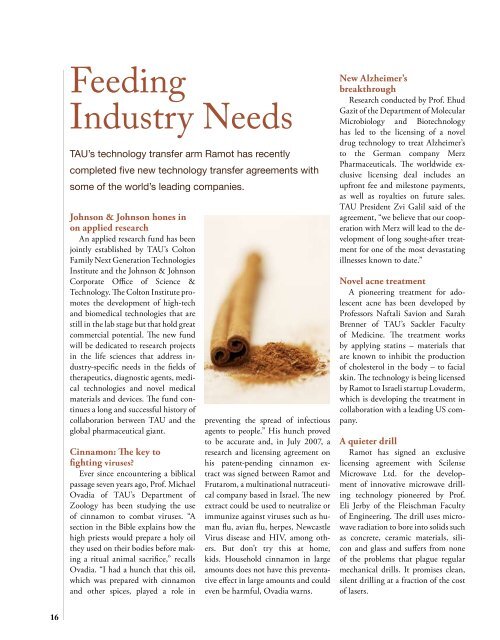Winter 2007/08
Winter 2007/08
Winter 2007/08
You also want an ePaper? Increase the reach of your titles
YUMPU automatically turns print PDFs into web optimized ePapers that Google loves.
Feeding<br />
Industry Needs<br />
TAU’s technology transfer arm Ramot has recently<br />
completed five new technology transfer agreements with<br />
some of the world’s leading companies.<br />
Johnson & Johnson hones in<br />
on applied research<br />
An applied research fund has been<br />
jointly established by TAU’s Colton<br />
Family Next Generation Technologies<br />
Institute and the Johnson & Johnson<br />
Corporate Office of Science &<br />
Technology. The Colton Institute promotes<br />
the development of high-tech<br />
and biomedical technologies that are<br />
still in the lab stage but that hold great<br />
commercial potential. The new fund<br />
will be dedicated to research projects<br />
in the life sciences that address industry-specific<br />
needs in the fields of<br />
therapeutics, diagnostic agents, medical<br />
technologies and novel medical<br />
materials and devices. The fund continues<br />
a long and successful history of<br />
collaboration between TAU and the<br />
global pharmaceutical giant.<br />
Cinnamon: The key to<br />
fighting viruses?<br />
Ever since encountering a biblical<br />
passage seven years ago, Prof. Michael<br />
Ovadia of TAU’s Department of<br />
Zoology has been studying the use<br />
of cinnamon to combat viruses. “A<br />
section in the Bible explains how the<br />
high priests would prepare a holy oil<br />
they used on their bodies before making<br />
a ritual animal sacrifice,” recalls<br />
Ovadia. “I had a hunch that this oil,<br />
which was prepared with cinnamon<br />
and other spices, played a role in<br />
preventing the spread of infectious<br />
agents to people.” His hunch proved<br />
to be accurate and, in July <strong>2007</strong>, a<br />
research and licensing agreement on<br />
his patent-pending cinnamon extract<br />
was signed between Ramot and<br />
Frutarom, a multinational nutraceutical<br />
company based in Israel. The new<br />
extract could be used to neutralize or<br />
immunize against viruses such as human<br />
flu, avian flu, herpes, Newcastle<br />
Virus disease and HIV, among others.<br />
But don’t try this at home,<br />
kids. Household cinnamon in large<br />
amounts does not have this preventative<br />
effect in large amounts and could<br />
even be harmful, Ovadia warns.<br />
New Alzheimer’s<br />
breakthrough<br />
Research conducted by Prof. Ehud<br />
Gazit of the Department of Molecular<br />
Microbiology and Biotechnology<br />
has led to the licensing of a novel<br />
drug technology to treat Alzheimer’s<br />
to the German company Merz<br />
Pharmaceuticals. The worldwide exclusive<br />
licensing deal includes an<br />
upfront fee and milestone payments,<br />
as well as royalties on future sales.<br />
TAU President Zvi Galil said of the<br />
agreement, “we believe that our cooperation<br />
with Merz will lead to the development<br />
of long sought-after treatment<br />
for one of the most devastating<br />
illnesses known to date.”<br />
Novel acne treatment<br />
A pioneering treatment for adolescent<br />
acne has been developed by<br />
Professors Naftali Savion and Sarah<br />
Brenner of TAU’s Sackler Faculty<br />
of Medicine. The treatment works<br />
by applying statins – materials that<br />
are known to inhibit the production<br />
of cholesterol in the body – to facial<br />
skin. The technology is being licensed<br />
by Ramot to Israeli startup Lovaderm,<br />
which is developing the treatment in<br />
collaboration with a leading US company.<br />
A quieter drill<br />
Ramot has signed an exclusive<br />
licensing agreement with Scilense<br />
Microwave Ltd. for the development<br />
of innovative microwave drilling<br />
technology pioneered by Prof.<br />
Eli Jerby of the Fleischman Faculty<br />
of Engineering. The drill uses microwave<br />
radiation to bore into solids such<br />
as concrete, ceramic materials, silicon<br />
and glass and suffers from none<br />
of the problems that plague regular<br />
mechanical drills. It promises clean,<br />
silent drilling at a fraction of the cost<br />
of lasers.<br />
16
















